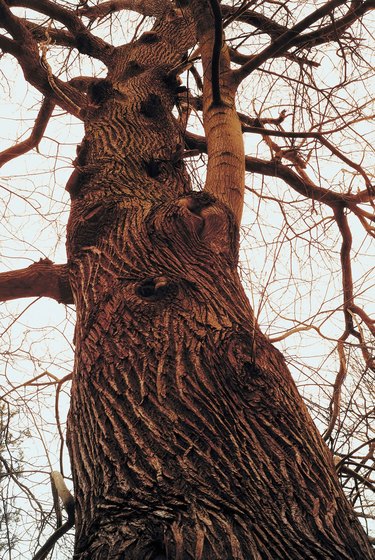
Constructing tree houses or forts, attaching hammocks or hanging birdhouses or feeders are a few of the instances in which it becomes necessary to puncture a tree with a screw, nail or other fastener. Oak trees are often the logical choice due both to their prevalence and their size, strength and longevity. The bur oak has a strong, spreading growth habit that makes it particularly ideal for tree houses.
Tree Health
Video of the Day
The primary concern with using any type of fastener that punctures the bark of an oak tree is the health of the tree. Screws and nails create a hole through the protective armor of the tree. This armor is the tree's first line of defense against diseases and bacterial infections. When an opening occurs, whether from fasteners or insects, the tree becomes vulnerable. While it is not always a death sentence, the tree may compartmentalize the source of the infection, and that part of the tree may perish.
Video of the Day
Zinc
Zinc screws are also known as galvanized screws. Trees need zinc in conjunction with other minerals in order to remain healthy. It would be highly unlikely that the affected tree's decline would be due to the zinc content; it is much more likely that the punctures themselves are contributing to a tree's symptoms. Galvanized fasteners are actually recommended because they last longer than non-galvanized ones, reducing the need for additional holes.
Fasteners
To use fasteners safely on trees, choose the correct fastener for the job at hand. Nails and screws are rarely recommended, as they do the greatest amount of damage. They are not strong enough to hold most things, requiring that more be used. Instead, for large structures, use bolts inserted into the proper diameter, pre-drilled pilot holes. Utilize washers, as well, to spread the load-bearing surface and even further reduce damage. Use smaller bolts for smaller projects like bird feeders, and eye bolts for hanging hammocks.
Straps
Sometimes straps can be used to provide even more protection for the tree. Use nothing smaller than a 1/2-inch width. Do not cinch it around the branch, but loop it over loosely, and adjust annually to prevent girdling. Never use cables, wire or chain, as they can girdle the branch they are on. Sometimes any object that you put into a tree gets swallowed up by the constant expansive growth of the tree, and becomes a hazard to the person who ends up using a chainsaw to take the tree down, or during milling of the timber.
- USDA Forest Service; Bur Oak; Paul S. Johnson
- The Treehouse Guide: Frequently Asked Questions
- Purdue Extension; Iron Chlorosis of Trees and Shrubs; Paul C. Pecknold; May 2001
- The Treehouse Guide: Fixtures and Fastenings
- Chron.com; Do Nails and Screws Harm Trees; Kathy Huber; July 2007
- The Treehouse Guide: Damage Caused by Treehouse Building
- Extension Notes Ontario: Maintaining Healthy Urban Trees